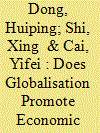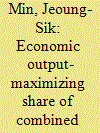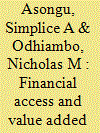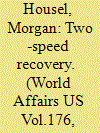|
|
|
Sort Order |
|
|
|
Items / Page
|
|
|
|
|
|
|
| Srl | Item |
| 1 |
ID:
182478


|
|
|
|
|
| Summary/Abstract |
This study aims to investigate whether globalisation promotes economic output in Sub-Saharan African countries in both the short run and the long run. Based on the latest version of the KOF globalisation index, we employ a newly developed bootstrap autoregressive distributed lag model to analyse this question. Compared to the traditional autoregressive distributed lag model, which ignores the degenerate cases, the new approach could avoid spurious cointegration. Results show that globalisation and economic output are positively correlated for most Sub-Saharan African countries, while the causal effect cannot be concluded except for a couple of exceptions. This finding implies that globalisation cannot guarantee an increase in economic output in the long run for most Sub-Saharan African countries. The Granger causality test shows that globalisation leads to economic output for Burundi, Gabon, Rwanda, Senegal and Zambia in the short run. Conversely, economic output leads to globalisation for Burkina Faso, Cameroon, Ghana, Kenya and Senegal. For Senegal, globalisation and economic output mutually determine each other and therefore form a positive spiral development path. Policymakers should be aware of the specific features of different economies in making sound globalisation policies to avoid the underlying adverse effects of global integration.
|
|
|
|
|
|
|
|
|
|
|
|
|
|
|
|
| 2 |
ID:
167018


|
|
|
|
|
| Summary/Abstract |
The combined heat and power (CHP) generation, which can produce both heat and electricity at the same time, is so efficient that it can reduce energy use and even mitigate CO2 and air pollutants emissions. For this reason, the share of CHP generation worldwide is increasing and the optimal share of CHP generation in electric power generation is a serious concern in South Korea. This article attempts to estimate the optimal share by modeling the plausible relationship between CHP generation and national output in the Cobb-Douglas production function setting and then deriving the output-maximizing share of CHP generation. The production function is estimated for annual data from 1995 to 2017 using several quantile regressions. The optimal share is computed to be 13.8%. Therefore, it is recommended that South Korea should increase the share of CHP generation slightly, given that the share was 8.6% in 2017. If the optimal CHP share instead of the actual CHP share had been achieved in 2017, GDP in 2017 could have increased by 0.82%.
|
|
|
|
|
|
|
|
|
|
|
|
|
|
|
|
| 3 |
ID:
186390


|
|
|
|
|
| Summary/Abstract |
This research assesses the importance of financial access on value added in three economic sectors in 25 countries in Sub-Saharan Africa using data for the period 1980–2014. The empirical evidence is based on the Generalized Method of Moments. Financial access is measured with private domestic credit, while the three outcome variables are: value added in the agricultural, manufacturing, and service sectors, respectively. Enhancing financial access does not significantly improve value added in the agricultural and manufacturing sectors, while enhancing financial access improves value added in the service sector. An extended analysis shows that, in order for the positive net incidence of enhancing credit access on value added to the service sector to be maintained, complementary policies are required when domestic credit to the private sector is between 77.50 percent and 98.50 percent of GDP. Policy implications are discussed.
|
|
|
|
|
|
|
|
|
|
|
|
|
|
|
|
| 4 |
ID:
128393


|
|
|
|
|
| Publication |
2014.
|
| Summary/Abstract |
The August 2013 gross domestic product report by the US Bureau of Economic Analysis drew little attention, but it contained a fairly remarkable piece of data: Inflation-adjusted GDP per capita in the United States hit a new all-time high in the second quarter of 2013, the first time a new high had been reached since 2007. Real consumer spending has hit a new high, too, and auto sales are at levels not seen since before the financial crisis. Millions of Americans are still searching for work and suffering financial hardship, but on average, by the broadest measures of economic performance, America's Great Recession is over. Few nations across the Atlantic can say the same. The eurozone slipped back into recession in 2012 for the second time in four years, and remains in an economic state that can be accurately described as miserable. Real economic output among eurozone nations remains three percentage points below its 2008 peak. Eurozone unemployment sits near twelve percent in late 2013, higher than the US ever experienced at the peak of its recession. These problems are as deeply human as they are economic or political. Each percentage point rise in Europe's unemployment rate has boosted its suicide rate by 0.79 percent, according to a study published in the medical journal the Lancet.
|
|
|
|
|
|
|
|
|
|
|
|
|
|
|
|
|
|
|
|
|